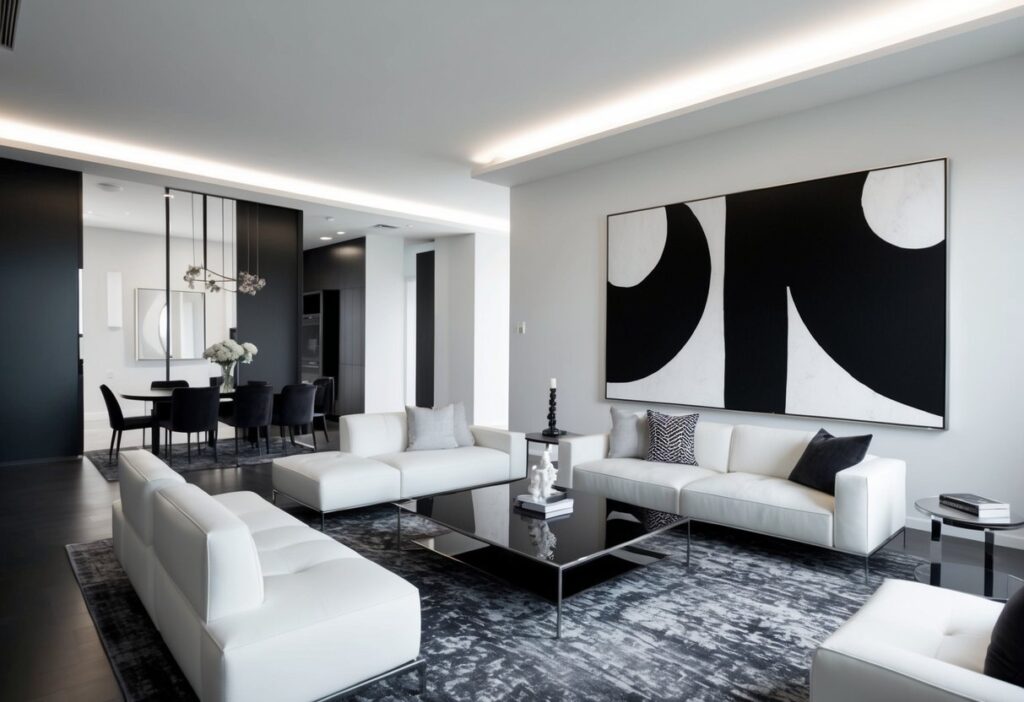Black and white minimalist art captures our attention through its simplicity and striking contrasts. This art style reduces complexity to bring focus to form and space, allowing us to appreciate the beauty in what is often overlooked. The absence of color heightens the emotional impact, evoking a sense of calm and clarity.
As we explore this unique genre, we will uncover the elements that define minimalist art and how artists use black and white to express deeper themes. Whether we are considering a piece for our homes or just appreciating its aesthetic, understanding its principles helps us see its value.
Minimalist art can transform a space, making it more inviting and thought-provoking. By incorporating these artworks into our decor, we create a serene environment that reflects a modern sensibility and appreciation for design.
Key Takeaways
- Black and white minimalist art emphasizes simplicity and contrasts.
- Understanding minimalist art enhances our appreciation of its beauty.
- Incorporating this art style can elevate our home decor.
Understanding Black and White Minimalist Art
In this section, we explore the key aspects of black and white minimalist art. We will look into its origins, the use of black and white in art, and characteristics that define this style.
Origins of Minimalism
Minimalism began in the late 1950s and early 1960s as a reaction to the complexity of abstract expressionism. Artists wanted to create work that focused on simplicity and essential forms.
Key figures in this movement included Donald Judd and Agnes Martin, who emphasized clean lines and basic shapes. Their work set the stage for a new way of seeing art, allowing viewers to engage with each piece more deeply.
Minimalism often sought to remove distractions, making the artwork itself the focal point. This emphasis on simplicity makes it timeless in its appeal.
Black and White in Art
Black and white have a powerful impact in minimalist art. These colors create strong contrasts that draw attention to form and space. The absence of color can lead to a clearer understanding of the composition.
Many artists use black and white to convey emotion and meaning without the distraction of color. This technique allows viewers to focus entirely on the shapes and textures in the work.
Artists like Frank Stella and Ellsworth Kelly have used these colors effectively. Their pieces demonstrate how minimalism can express complex ideas through simple means.
Characteristics of Minimalist Art
Minimalist art is defined by several key features. First, it often consists of simple geometric shapes and a limited color palette. This approach emphasizes clarity and directness.
Another characteristic is a focus on the material used in the artwork. Artists often want the viewer to appreciate the medium itself, whether it is canvas, metal, or wood.
Finally, minimalist art encourages personal interpretation. As viewers engage with the work, their experience becomes a vital part of the art itself. This relationship adds depth, making minimalist pieces resonate in a powerful yet understated way.
Incorporating Minimalist Art into Home Decor

We can enhance our home decor with minimalist art by focusing on the right pieces, understanding the role of art, and keeping things simple. Minimalist art adds depth while maintaining a clean aesthetic that suits various settings.
Choosing the Right Piece for Your Space
When selecting wall art for our home, size matters. Large wall art can serve as a focal point in a room. For spaces like the bedroom, we might opt for softer pieces with contrasting colors to promote tranquility.
We should consider materials too. Canvas art can provide a modern look, while wood adds warmth and texture. It’s important that our choices reflect our personal styles while complementing existing decor.
The Role of Art in Interior Design
Art plays a key role in how our spaces feel. It can transform a plain room into an inviting one. Minimalist art, with its simplicity, encourages a calm atmosphere.
Incorporating art in areas like living rooms or home offices can inspire creativity and relaxation. We can choose pieces that resonate with us, pulling together the room’s aesthetic while keeping it uncluttered.
Maintaining Simplicity in Decoration
To stay true to minimalist ideals, we should maintain a focus on simplicity. This means avoiding overcrowding our walls with too many pieces.
Instead, we might select a few impactful items that enhance our space without overwhelming it. Using a balance of colors and textures helps create harmony. For instance, pairing black and white pieces with industrial elements can add sophistication.
Remember, personalization within simplicity can make our decor unique and inviting.
Frequently Asked Questions

In this section, we will explore various aspects of black and white minimalist art. Our focus will be on its characteristics, influence on design, notable artworks, and tips for integration in decor.
What characterizes black and white minimalist art?
Black and white minimalist art relies on simplicity and contrasts. It often features basic shapes and lines. The absence of color emphasizes form and texture, creating a clean and impactful aesthetic.
How does minimalist art influence interior design, particularly using a monochrome palette?
Using a monochrome palette can make spaces feel modern and open. It allows for easy matching with different furniture styles. Black and white pieces can serve as focal points while promoting harmony in a room.
What are notable examples of large-scale black and white minimalist artworks?
Some famous examples include works by artists like Donald Judd and Ellsworth Kelly. Large installations can dominate spaces with their boldness. These pieces invite viewers to reflect on proportion and balance.
How can minimalist principles be applied to black and white digital wallpaper designs?
We can use geometric patterns and simple lines for digital wallpaper. This keeps the design subtle yet engaging. A well-chosen black and white pattern can enhance the aesthetic of any digital space.
Who are some prominent artists known for their black and white minimalist works?
Prominent artists include Frank Stella and Agnes Martin. Their works often focus on minimal shapes and consistent patterns. They greatly influenced the minimalist movement with their distinctive styles.
How can one integrate black and white minimalist art into living room decor effectively?
We can start by selecting one or two large pieces as focal points. Mixing different textures can add depth without cluttering. Keeping surrounding decor simple ensures that the artwork remains the highlight.


